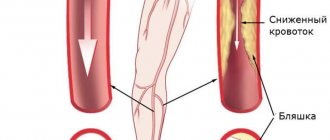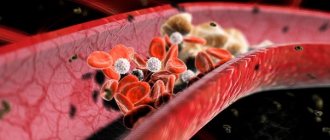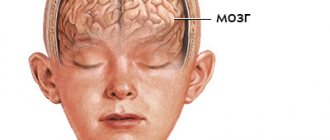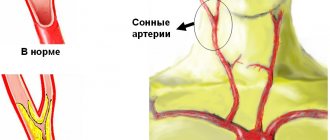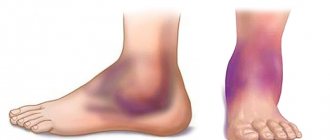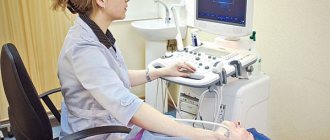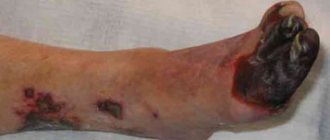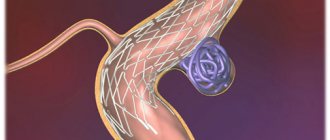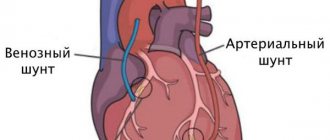© Author: A. Olesya Valerievna, candidate of medical sciences, practicing physician, teacher at a medical university, especially for SosudInfo.ru (about the authors)
Atherosclerosis of the BCA (brachiocephalic arteries) is one of the most common localizations of the atherosclerotic process, detected mainly in elderly and senile people and leading to hemodynamic disorders in the brain.
atherosclerotic deposits in the brachiocephalic arteries
Damage to blood vessels by atherosclerotic plaques is widespread among the world's population. This insidious disease begins gradually, even in adulthood, when a person leads an active lifestyle, works a lot and does not pay enough attention to his health due to lack of free time, still feeling good and lack of thoughts about approaching old age with its consequences.
Meanwhile, the initial signs of atherosclerosis can be detected already at the age of 40-45 years, more often in men. Women during this period are protected from atherosclerosis by sex hormones, but as menopause sets in and their concentrations decrease, the risk of pathology increases, and by the age of 65-70, the incidence of atherosclerosis, including the brachiocephalic arteries, becomes approximately the same in both sexes.
Atherosclerosis of the brachiocephalic arteries acquires particular significance due to impaired blood supply to the brain and the risk of the most dangerous condition - stroke, although the chronic manifestation of the pathology in the form of the development of dementia also causes a lot of trouble and sooner or later leads to the death of the patient.
The brachiocephalic arteries include the brachiocephalic trunk, left subclavian and common carotid arteries. These large trunks originate directly from the aorta and branch into vessels of smaller diameter that participate in the formation of the arterial (Circle of Willis) circle of the brain, which supplies blood to the nervous tissue.
The vertebrates begin from the subclavian arteries, which at the base of the brain merge into the basilar artery, a large artery that gives rise to the sources of blood supply to the posterior part of the cerebrum and cerebellum (posterior cerebral). The pathology of the vertebral arteries is known to many; most often it is their asymmetry or local narrowings that are congenital in nature, and atherosclerosis acquired during life greatly aggravates the lack of blood flow and contributes to cerebral ischemia.
The structure of the BCA and the cerebral arteries that feed from them
In order not to miss the onset of the disease, people at risk need to carefully monitor their well-being and regularly visit a doctor, undergo appropriate tests and take medications prescribed by a specialist. Timely diagnosis and treatment can slow the progression of atherosclerosis and prevent complications, the most dangerous of which is stroke.
About the brachiocephalic arteries
The brachiocephalic arteries (BCA) arise from the aorta and are divided into the brachycephalic trunk, two common carotid arteries, two subclavian arteries and the vertebral arteries extending from them. At the base of the brain, they all form the Circle of Willis, which distributes blood equally between all parts of the brain. Restrictions in the patency of these arteries lead to disturbances in cerebral blood flow.
Like other large arteries of the circulatory system, the BCA is susceptible to atherosclerosis. This concept refers to the gradual narrowing of the vascular lumen, which occurs as a result of the accumulation of cholesterol deposits on the vascular walls. Over time, they form rather dense plaques that interfere with normal blood flow. As a result of arterial stenosis, organ tissues experience a lack of oxygen. When this process occurs gradually, chronic forms of diseases such as chronic cerebral ischemia develop. If the blood supply to the affected vessel is completely stopped, a life-threatening condition occurs - a stroke.
Causes of the disease
The main reason for the cessation of a full supply of blood to the brain is stenosis and blockage of the brachiocephalic arteries. The trunk has the shape of a slingshot, so this anatomical feature of the structure creates conditions for unnecessary trauma in this arterial area.
The etiology of damage to the brachiocephalic vessels is not fully understood by specialists, but doctors identify the main factors influencing the development of atherosclerosis in the BCA area:
- smoking and consuming large doses of strong drinks - the body’s vessels are constantly clogged with tars, carcinogens and are negatively affected by ethyl alcohol. Because of this, non-stenotic atherosclerosis develops or worsens, over time causing pathological narrowing and spasm of the capillaries;
- long-term use of oral contraceptives in female patients;
- age over 50 years;
- gender – in women, signs of vascular blockage are less pronounced than in men, since their arterial tone and elasticity are maintained by the release of the hormone estrogen. But once you reach age 50, the chances of large artery blockages also increase for women;
- concomitant diseases - with a long course of arterial hypertension, diabetes mellitus and pathologies of the endocrine system, all pathological processes in the capillaries progress faster;
- high content of “bad” type cholesterol in the blood plasma;
- unhealthy diet with a predominance of animal fats, lack of vegetables, herbs, grains, fish and sources of Omega 3 acids in the diet;
- excess weight - the body of an obese person consumes 10 times more oxygen during movement, the vessel is in a narrowed spastic state. And since obese patients often suffer from blood pressure and diabetes, the course of atherosclerosis becomes more dangerous and aggressive.
Frequent stress can aggravate the condition of a patient with brachiocephalic artery stenosis
Capillaries clogged with solid cholesterol deposits cannot fully pass blood. And their additional narrowing during stressful situations provokes the early manifestation of signs of a dangerous pathology. Heredity also plays an important role in the development of atherosclerotic changes in the arteries.
If a person has relatives who already suffer from some type of atherosclerosis, then the chances of blocking blood vessels with cholesterol are significantly increased for him. Especially if a healthy person constantly smokes, drinks alcohol, does not follow the rules of a balanced diet and moves little.
No ads 2
Symptoms
Atherosclerosis of the BCA develops gradually, causing the patient to experience characteristic symptoms:
- dizziness associated with a sharp turn of the head
- itching and tingling in the arms and legs;
- sudden nausea, swaying;
- speech impairment, blurred vision, numbness;
- noise in ears;
- short-term loss of vision;
- episodic numbness of half the body.
Symptoms of atherosclerotic lesions of brachiocephalic vessels
When the BCA is affected by atherosclerosis, two “scenarios” for the development of events are possible:
- Chronic continuously increasing hypoxia underlying discirculatory encephalopathy or chronic cerebral ischemia;
- Acute occlusion of the lumen with complete cessation of blood flow and the formation of a focus of necrosis.
The most common symptoms in patients suffering from changes in the BCA are signs of oxygen starvation of the brain:
- Dizziness;
- Headache;
- “Floaters” before the eyes, a feeling of a veil;
- Fatigue, feeling tired;
- Insomnia;
- Presyncope and episodes of loss of consciousness;
- Decreased intellectual abilities, memory, difficulty concentrating;
- Behavioral changes, severe mental disorders.
Signs of the disease are absent for a long time or are expressed to such an extent that it is easier to associate them with overwork, hard work, and emotional distress. At the initial stage, the plaque does not narrow the lumen to a significant extent, and may even have a planar arrangement; collaterals provide blood supply to the brain, so the manifestations are inconsistent, scarce and nonspecific.
One of the earliest and most common signs of atherosclerosis of the brachiocephalic vessels is dizziness. It intensifies with sharp turns of the head, when the vessels do not have time to redirect the blood bypassing the affected area. Attacks of dizziness may be accompanied by poor coordination of movements, falls and injuries, so patients should be very careful.
As the volume of the plaque and the degree of occlusion of the artery lumen increases, the symptoms become more severe. The patient begins to be bothered by persistent headaches that are difficult to treat with analgesics, associated with increasing cerebral ischemia, which the body is no longer able to eliminate on its own. With fluctuations in blood pressure, especially in the case of a decrease or constant hypotension, the severity of ischemia will worsen.
Atherosclerosis with stenosis causes severe symptoms of oxygen starvation of the brain, in which sooner or later signs of incipient dementia appear. Patients suffer from forgetfulness, become irritable, prone to depression, lose appetite and motivation for directed actions, untidiness, inconsistency of thoughts and judgments appear.
The advanced stage of atherosclerosis of the BCA with damage to the branches carrying blood to the brain is characterized by all the signs of vascular dementia, which can be observed in elderly and senile people. The patient becomes inadequate, does not orient himself in space and himself, speech is incoherent and meaningless, and in the terminal stage he is no longer capable of movement and self-care, requiring constant monitoring and care.
The described symptoms relate to chronic progressive atherosclerosis with stenosis, but without vascular accidents. The situation is different when the artery is completely blocked. If the plaque has closed its lumen or has become a source of embolic complications with obstruction of smaller branches, then signs of a stroke will occur:
- Paresis and paralysis;
- Sensitivity disorders;
- Disorders of speech, hearing, vision;
- Disorders of the pelvic organs;
- Coma.
This is only a part of the possible neurological disorders that occur due to a stroke. It is worth noting that atherosclerosis of the basilar and posterior cerebral arteries almost always causes severe strokes due to the large caliber of the arteries and the insufficient reserve capacity of blood flow in the posterior parts of the brain.
Atherosclerosis of the extracranial branches of the BCA can cause symptoms of blood flow insufficiency in the upper extremities. Patients complain of a feeling of numbness, weakness, crawling sensations and decreased sensitivity in the hands.
Complications
Atherosclerosis of the brachiocephalic arteries is also dangerous because even in its initial and slowly progressing form there is a risk of plaque rupture and embolism into the vessels of the brain. Aneurysms occur on weakened vessel walls, the rupture of which leads to cerebral hemorrhage and death. The most common complication of stenosing atherosclerosis of the BCA is stroke. Its consequences include paralysis, brain dysfunction, and death. Timely consultation with a doctor and special diagnostics reduce the risks of stroke and other dangerous complications.
Diagnostic measures
To make a diagnosis, a general practitioner or cardiologist will need to:
- patient interview;
- examination of the patient;
- auscultation and percussion of the heart and lungs;
- laboratory blood tests - general clinical (blood + urine), study of lipid composition (lipidogram), serum glucose;
- triplex scanning of the brachiocephalic arteries;
- MRI of the brain (if indicated);
- BCA angiography.
Diagnosis and treatment
Diagnosis and treatment of atherosclerosis in the early stages allows you to avoid complications and stop the growth of atheromatous plaques. For symptoms of cerebral circulatory disorders, Doppler ultrasound and magnetic resonance angiography of cerebral vessels are required.
In the early stages of development of BCA atherosclerosis, it is recommended to take medications and a special diet to reduce blood cholesterol levels. In more complex and dangerous cases, when the lumen of the arteries is too narrowed, surgical intervention is indicated. Depending on the degree of damage to the arteries and the patient’s condition, endovascular surgery is prescribed - installation of a stent or open surgery to remove plaque from the vessel - endarterectomy.
Classification
There are several stages of non-stenotic atherosclerosis of the BCA.
Among them:
- First stage (fat stain). The vascular wall is prone to swelling and loosening. Special enzymes aim to dissolve lipids and provide protection. But over time, the body’s protective properties decrease. As a result, complex compounds consisting of proteins and lipids are formed on the walls.
- Second stage (liposclerosis). At this stage, the disease is characterized by the proliferation of fatty deposits. A plaque gradually forms, which consists of connective tissue and fats. At first the deposit is liquid and can be dissolved.
- Third stage (atherocalcinosis). At this stage, calcium salts are deposited in the plaques. The formation grows and behaves unstable, narrowing the lumen and causing the situation to worsen. The risk of lumen blockage increases.
Minimally invasive methods of treating stenosing atherosclerosis of BCA
The clinic is equipped with equipment for performing several types of hemocorrection. Often, a correctly selected method in combination with drug treatment provides excellent results without surgical intervention. Hemocorrection allows you to eliminate certain substances from the blood (in this case cholesterol), and medications prevent their reappearance. After completing the course of treatment, the patient receives recommendations for changing diet and lifestyle. Positive results can often be maintained for many years.
Prevention
The prognosis for the development of the disease is determined by the patient’s lifestyle. The progression of the pathology can be stopped by eliminating existing risk factors and active drug therapy.
Prevention of vascular problems should be carried out comprehensively.
If there is any risk of developing pathology, you must:
- switch to proper nutrition;
- stop smoking;
- reduce stress factors;
- normalize weight;
- devote time to physical activity.
Prevention is impossible without regular examinations and visits to the doctor. We recommend seeing a cardiologist for anyone who has a history of problems or has negative heredity.
Risk factors
In addition to the age-related changes in the condition of blood vessels that we have already mentioned, atherosclerosis is caused by factors associated with a person’s habits and lifestyle. Smoking, alcohol abuse or fatty foods increase the risk of developing atherosclerosis. Nicotine causes vascular spasms, and alcohol and junk food increase cholesterol levels, which contributes to the formation of atherosclerotic plaques. People who lead a sedentary lifestyle are at risk. Among the causes of coronary heart disease and other vascular diseases, hereditary predisposition is also noted.
Kinds
Any arteries or vessels can be affected. The lesions described below have the most pronounced symptoms. Each species has its own characteristics, most often several of them develop simultaneously. Damage to the blood vessels of the brachiocephalic arteries, aorta, and lower extremities is considered especially common.
Brachiocephalic arteries
For the body to be viable, it is necessary to ensure uninterrupted blood flow to the brain. The following main ways are involved:
- through the carotid artery;
- left subclavian artery;
- brachiocephalic trunk.
The brachiocephalic artery is one of the branches of the aorta through which blood flow reaches the brain. Due to its parameters and accessibility, cholesterol plaques often form in it, affecting the walls of blood vessels. The main symptoms of non-stenotic atherosclerosis of the extracranial brachiocephalic arteries are:
- frequent tinnitus;
- dizziness;
- migraine attacks;
- fainting state;
- numbness of the limbs;
- prostration.
Symptoms of damage to parts of the bts also include hair loss, brittle nails, deterioration of the skin, and changes in gait. Many people view these problems as cosmetic, delaying treatment.
Non-stenotic atherosclerosis bca is considered one of the most dangerous forms of atherosclerosis. Damage to the extracranial vessels that supply blood to the brain and neck causes a lot of discomfort, worsening the quality of life. However, given that this often manifests itself in older people, such symptoms are attributed to age and left unattended. Non-stenotic atherosclerosis of the brachiocephalic arteries may also involve damage to the carotid arteries.
The larger the plaque becomes, the stronger the disruption of the blood flow system, given the proximity of the arteries to the brain, this condition is life-threatening
Aorta
The aorta is the largest blood vessel. Often, those parts of the aorta that are located in the chest and/or peritoneum are susceptible to non-stenotic atherosclerosis of the aorta. The danger lies in the non-obviousness of the symptoms; even if the plaques have affected every centimeter of the aorta, the person may not feel it.
The main signs of aortic plaque damage include:
- painful sensations in the chest, peritoneum;
- frequent headaches;
- causeless coughing attacks;
- hoarseness, hoarseness.
Arteries of the lower extremities
Painful sensations appear in the hips, lower back, buttocks, and the pain syndrome is especially pronounced in the calf muscles. The development of the disease occurs in several stages, most patients detect it in the second or third:
- First. Pain in the lower extremities is felt only after intense physical activity. Many people ignore it, chalking it up to fatigue or poor fitness.
- Second. Painful sensations occur even after minor exertion. Short walking and doing household chores are accompanied by severe discomfort.
- Third. Due to pain, any load on the legs is limited. A person cannot stand for a long time, the maximum possible distance to move is no more than 50 m.
- Fourth. Wounds appear on the limbs, developing into gangrene. This happens due to a deficiency of nutrients, vital microelements to the feet.
Other types of disease
Non-stenotic atherosclerosis can also affect other elastic arteries in the body, although this is less common. In addition to the sections of the brachiocephalic arteries, aorta and lower extremities, plaques can form on:
- main arteries;
- pulmonary;
- subclavian;
- carotid;
- extracranial.
The disruption of the arteries occurs gradually, first the plaques affect the large ones, then the smaller ones. The deposition of cholesterol plaques can occur chaotically, therefore, when at least some of them appear on one type of artery, there is immediately a risk of their formation on others - the entire cardiovascular system may suffer.
